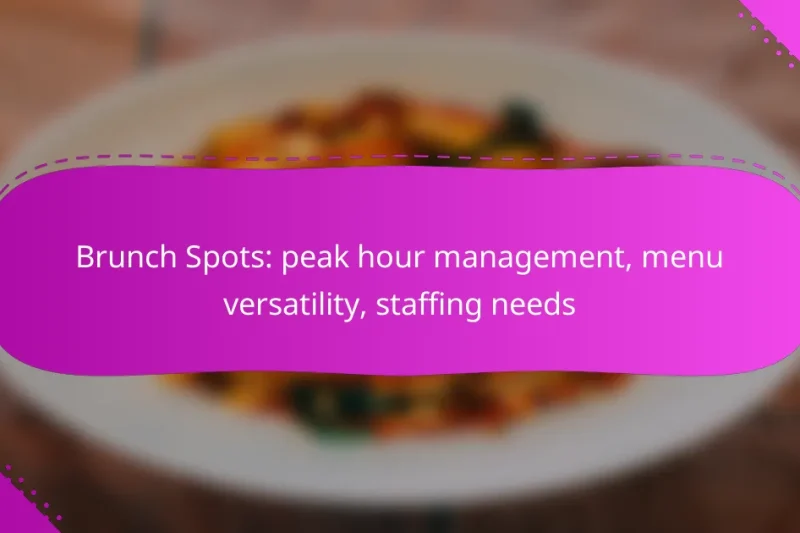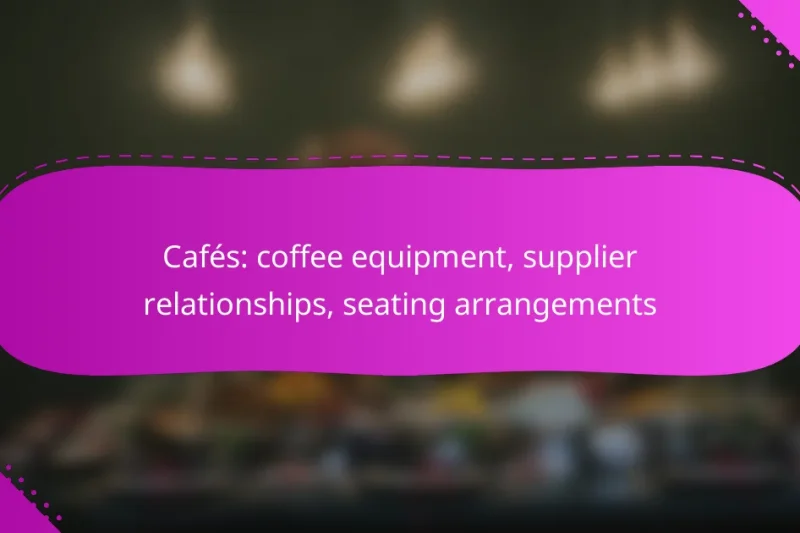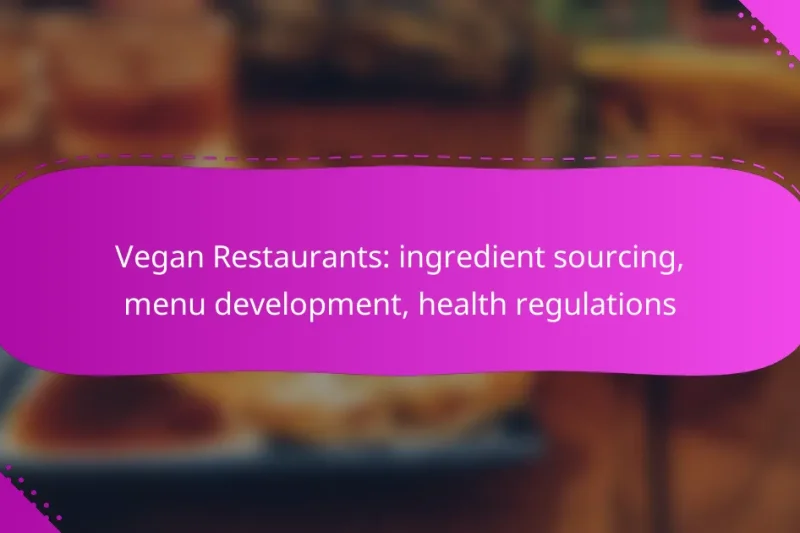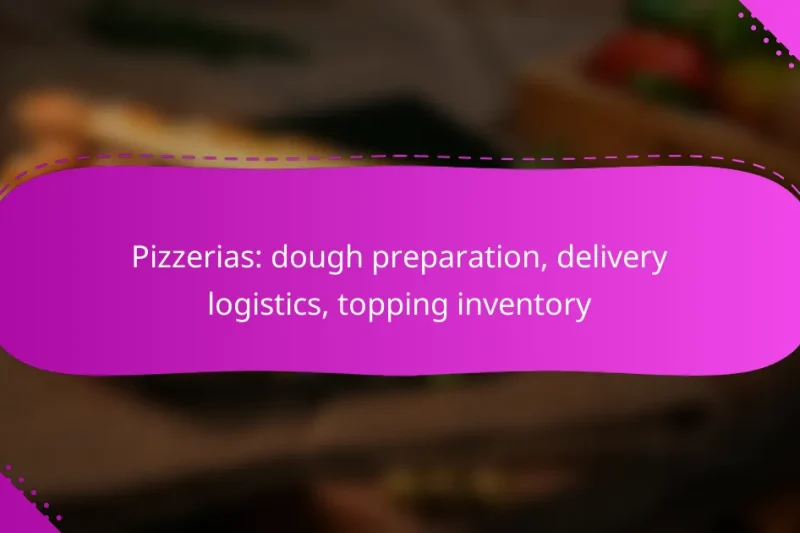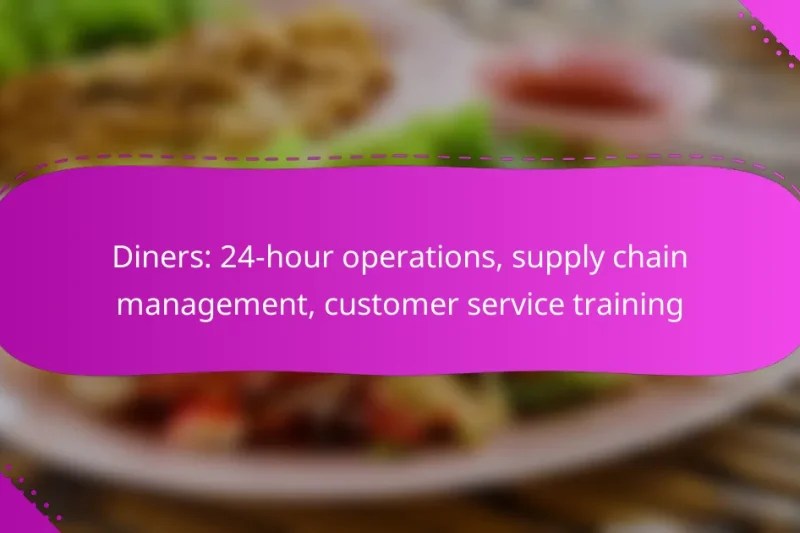Brunch spots face unique challenges during peak hours, necessitating strategic management to optimize customer experience and … Brunch Spots: peak hour management, menu versatility, staffing needsRead more
Logistics of Running Various Restaurant Styles
Running a restaurant involves navigating a complex web of logistics that vary significantly across different styles, from fast food to casual dining and food trucks. Each type requires tailored strategies for supply chain management, staffing, equipment, and regulatory compliance to ensure operational efficiency and customer satisfaction. Understanding these unique logistical challenges is essential for success in the competitive restaurant industry.
Cafés: coffee equipment, supplier relationships, seating arrangements
Cafés in Canada thrive on the right combination of quality coffee equipment, reliable supplier relationships, and … Cafés: coffee equipment, supplier relationships, seating arrangementsRead more
Ethnic Cuisine Restaurants: ingredient sourcing, cultural authenticity, menu planning
Ethnic cuisine restaurants thrive on the delicate balance of sourcing authentic ingredients while honoring cultural traditions. … Ethnic Cuisine Restaurants: ingredient sourcing, cultural authenticity, menu planningRead more
Vegan Restaurants: ingredient sourcing, menu development, health regulations
Vegan restaurants play a crucial role in promoting sustainable eating by sourcing ingredients locally and focusing … Vegan Restaurants: ingredient sourcing, menu development, health regulationsRead more
Pizzerias: dough preparation, delivery logistics, topping inventory
Pizzerias play a vital role in the culinary landscape, with a focus on perfecting dough preparation … Pizzerias: dough preparation, delivery logistics, topping inventoryRead more
Pop-Up Restaurants: temporary setups, marketing strategies, location scouting
Pop-up restaurants offer a unique opportunity for culinary entrepreneurs to test concepts and engage with customers … Pop-Up Restaurants: temporary setups, marketing strategies, location scoutingRead more
Diners: 24-hour operations, supply chain management, customer service training
24-hour diners play a crucial role in the food service industry by balancing operational efficiency with … Diners: 24-hour operations, supply chain management, customer service trainingRead more
Fast Casual: efficient kitchen layout, quick service protocols, delivery options
Fast casual restaurants thrive on efficiency, requiring a well-optimized kitchen layout that promotes a smooth workflow … Fast Casual: efficient kitchen layout, quick service protocols, delivery optionsRead more
Food Trucks: route planning, permits and licenses, equipment needs
Operating a food truck involves careful route planning to enhance sales and efficiency, utilizing technology to … Food Trucks: route planning, permits and licenses, equipment needsRead more
Casual Dining: staffing requirements, inventory management, customer flow
Casual dining establishments require careful consideration of staffing needs, balancing front-of-house and back-of-house roles to ensure … Casual Dining: staffing requirements, inventory management, customer flowRead more
What are the logistics of running a fast food restaurant in Canada?
Running a fast food restaurant in Canada involves managing a streamlined supply chain, maintaining adequate staffing, ensuring proper equipment, adhering to health regulations, and implementing effective customer service strategies. Each of these logistics plays a crucial role in the overall efficiency and success of the restaurant.
Supply chain management
Effective supply chain management is vital for fast food restaurants to ensure consistent quality and availability of ingredients. Establishing relationships with reliable suppliers for fresh produce, meats, and other essentials can help maintain menu standards and control costs.
Consider using local suppliers to reduce transportation costs and support community businesses. Regularly reviewing supplier performance and pricing can lead to better deals and improved service levels.
Staffing requirements
Fast food restaurants typically require a mix of full-time and part-time staff to manage peak hours efficiently. Positions often include cooks, cashiers, and shift supervisors, with a focus on hiring individuals who can work in a fast-paced environment.
Training programs should be established to ensure staff are familiar with food safety practices and customer service expectations. Retaining employees can be challenging, so offering competitive wages and flexible schedules can help reduce turnover.
Equipment needs
Essential equipment for a fast food restaurant includes fryers, grills, ovens, and refrigeration units. Investing in high-quality, energy-efficient equipment can reduce long-term operational costs and improve food quality.
Regular maintenance of equipment is crucial to avoid breakdowns during busy hours. Consider creating a checklist for routine inspections and repairs to keep everything running smoothly.
Health regulations
In Canada, fast food restaurants must comply with local health regulations, including food safety standards set by provincial health authorities. This includes proper food handling, storage, and sanitation practices to prevent foodborne illnesses.
Regular health inspections are conducted, so maintaining accurate records of food temperatures and cleaning schedules is essential. Training staff on these regulations can help ensure compliance and avoid penalties.
Customer service strategies
Customer service is a key differentiator for fast food restaurants. Implementing strategies such as quick service, friendly staff interactions, and efficient order processing can enhance the customer experience.
Gathering customer feedback through surveys or social media can provide insights into areas for improvement. Training staff to handle complaints effectively can also turn negative experiences into positive ones, fostering customer loyalty.
How to optimize delivery logistics for casual dining restaurants?
To optimize delivery logistics for casual dining restaurants, focus on efficient partnerships, technology integration, and menu design tailored for delivery. Streamlining these areas can enhance customer satisfaction and operational efficiency.
Partnerships with delivery services
Establishing strong partnerships with reliable delivery services is crucial for casual dining restaurants. Consider collaborating with popular platforms like Uber Eats, DoorDash, or local services that cater to your area. Evaluate their fees, delivery times, and customer reach to select the best fit for your restaurant’s needs.
Regularly review performance metrics such as delivery times and customer feedback to ensure the partnership remains beneficial. Maintaining open communication with delivery partners can help address issues promptly and improve service quality.
Technology integration
Integrating technology into your delivery logistics can streamline operations and enhance customer experience. Implement a robust point-of-sale (POS) system that connects with delivery platforms to manage orders efficiently. This integration minimizes errors and speeds up the order processing time.
Consider using GPS tracking systems to monitor deliveries in real-time. This feature allows customers to track their orders, reducing inquiries and improving satisfaction. Additionally, investing in an online ordering system can simplify the ordering process for customers.
Menu design for delivery
Designing a menu specifically for delivery is essential to ensure food quality and customer satisfaction. Focus on items that travel well and maintain their taste and presentation during transit. Avoid dishes that are overly complex or require extensive preparation time.
Incorporate a selection of popular items that can be easily packaged and consider offering family-style meals or bundles to encourage larger orders. Regularly update the menu based on customer preferences and seasonal ingredients to keep offerings fresh and appealing.
What are the key considerations for food truck operations in urban areas?
Food truck operations in urban areas require careful planning around location, regulations, and menu adaptability. These factors significantly influence the success and compliance of the business.
Location selection
Choosing the right location is crucial for food truck success. High foot traffic areas such as business districts, parks, or event venues can attract more customers. Consider proximity to competitors and local demand for specific cuisines.
Evaluate potential spots based on visibility, accessibility, and parking regulations. Some cities may have designated food truck zones, while others may restrict operations in certain areas. Researching these factors can help avoid costly fines and maximize sales.
Permitting and regulations
Food trucks must comply with local health codes and obtain necessary permits to operate legally. This often includes health department inspections, business licenses, and food handling permits. Regulations can vary widely by city, so it’s essential to check local requirements.
Be aware of zoning laws that dictate where food trucks can park and operate. Some municipalities may have restrictions on operating hours or require special permits for events. Staying informed about these regulations can prevent disruptions to your business.
Menu flexibility
Having a flexible menu is vital for food truck operations, allowing you to adapt to customer preferences and seasonal ingredients. A smaller, focused menu can streamline operations and reduce waste, while still offering variety to attract different customers.
Consider offering daily specials or rotating menu items to keep offerings fresh and exciting. This approach can help you respond to trends and customer feedback effectively, ensuring your food truck remains competitive in a dynamic urban environment.
How to manage inventory for fine dining establishments?
Managing inventory for fine dining establishments requires meticulous attention to detail and a strategic approach. Key factors include maintaining optimal stock levels, ensuring ingredient freshness, and minimizing waste to enhance profitability.
Supplier relationships
Building strong relationships with suppliers is crucial for fine dining restaurants. Reliable suppliers can provide high-quality ingredients consistently, which is essential for maintaining menu standards. Establishing clear communication and negotiating favorable terms can lead to better pricing and priority during peak seasons.
Consider visiting suppliers regularly to foster these relationships. This not only helps in understanding their capabilities but also allows for discussions about seasonal products and potential exclusives that can enhance your menu.
Seasonal menu planning
Seasonal menu planning is vital for managing inventory effectively in fine dining. By aligning your menu with seasonal ingredients, you can reduce costs and ensure freshness. This approach also allows you to highlight local produce, which can attract customers looking for authentic dining experiences.
Regularly review and adjust your menu based on seasonal availability. Aim to incorporate a mix of staple items and seasonal specials to keep the offering dynamic while managing inventory efficiently.
Waste management practices
Implementing effective waste management practices is essential for fine dining restaurants to minimize costs and environmental impact. Start by tracking food waste to identify patterns and areas for improvement. This data can help in adjusting purchasing decisions and portion sizes.
Consider using techniques such as composting or donating excess food to local charities. Not only does this reduce waste, but it also enhances your restaurant’s reputation in the community. Regular staff training on waste reduction strategies can further support these efforts.
What are the challenges of running a buffet restaurant?
Running a buffet restaurant presents unique challenges, primarily related to food management, customer flow, and cost control. Operators must balance food quality and variety while managing waste and ensuring a positive dining experience.
Food Quality and Safety
Maintaining food quality and safety is crucial in a buffet setting. Dishes must be kept at safe temperatures to prevent foodborne illnesses, requiring effective temperature control systems. Regular monitoring and adherence to local health regulations are essential to ensure compliance.
Implementing a rotation system for food items can help maintain freshness. For example, using a first-in, first-out (FIFO) approach ensures older items are served before newer ones, reducing waste and enhancing quality.
Cost Control
Cost control is a significant challenge for buffet restaurants, as they must manage food costs while offering a diverse menu. Operators should establish a budget for food purchases and regularly analyze food usage to identify trends and adjust offerings accordingly.
Utilizing seasonal ingredients can help reduce costs while maintaining variety. Additionally, portion control measures can prevent excessive waste, ensuring that each dish is replenished only as needed.
Customer Flow Management
Efficient customer flow management is vital to ensure a pleasant dining experience in a buffet restaurant. Operators need to design the layout to minimize congestion and facilitate easy access to food stations.
Implementing a timed entry system can help manage peak hours and reduce wait times. For instance, allowing reservations for specific time slots can enhance customer satisfaction and streamline service.
